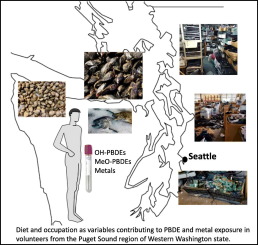当前位置:
X-MOL 学术
›
Sci. Total Environ.
›
论文详情
Our official English website, www.x-mol.net, welcomes your feedback! (Note: you will need to create a separate account there.)
Occupational and dietary differences in hydroxylated and methoxylated PBDEs and metals in plasma from Puget Sound, Washington, USA region volunteers.
Science of the Total Environment ( IF 9.8 ) Pub Date : 2020-01-07 , DOI: 10.1016/j.scitotenv.2020.136566 Irvin R Schultz 1 , Li-Jung Kuo 1 , Valerie Cullinan 1 , Sara Cade 1
Science of the Total Environment ( IF 9.8 ) Pub Date : 2020-01-07 , DOI: 10.1016/j.scitotenv.2020.136566 Irvin R Schultz 1 , Li-Jung Kuo 1 , Valerie Cullinan 1 , Sara Cade 1
Affiliation

|
Electronic waste (E-waste) recycling is a rapidly growing occupation in the USA with the potential for elevated exposure to flame retardants and metals associated with electronic devices. We previously measured polybrominated diphenyl ethers (PBDEs) in plasma from E-waste workers and found them similar to non-E-waste workers. This study focused on structurally related PBDE derivatives, the hydroxylated (OH-PBDEs) and methoxylated (MeO-PBDEs) forms along with metals known to occur in E-waste. Humans can metabolize PBDEs and some MeO-PBDEs into OH-PBDEs, which is a concern due to greater health risks associated with OH-PBDEs. We measured 32 different OH-PBDEs and MeO-PBDEs in plasma samples provided by 113 volunteers living in the greater Puget Sound region of Washington State, USA. We measured 14 metals in a subset of 10 E-waste and 10 non-E-waste volunteers. Volunteers were selected based on occupational and dietary habits: work outdoors and consume above average amounts of seafood (outdoor), electronic waste recycling (E-waste) or non-specific indoor occupations (indoor). A two-week food consumption diary was obtained from each volunteer prior to blood sampling. OH-PBDEs were detected in all volunteers varying between 0.27 and 102 ng/g/g-lipid. The MeO-PBDEs were detected in most, but not all volunteers varying between n.d. - 60.4 ng/g/g-lipid. E-waste recyclers had OH-PBDE and MeO-PBDE plasma levels that were similar to the indoor group. The outdoor group had significantly higher levels of MeO-PBDEs, but not OH-PBDEs. Comparison of plasma concentrations of BDE-47 with its known hydroxylated metabolites suggested OH-PBDE levels were likely determined by biotransformation and at least two subpopulations identified differing in their apparent rates of OH-PBDE formation. The metals analysis indicated no significant differences between E-waste workers and non-E-waste workers. Our results indicate E-waste workers do not have elevated plasma levels of these contaminants relative to non-E-waste workers.
中文翻译:

来自美国华盛顿州普吉特海湾地区志愿者的血浆中羟化和甲氧基化的多溴二苯醚和金属的职业和饮食差异。
在美国,电子废物(电子废物)回收是一项快速增长的职业,有可能增加与电子设备相关的阻燃剂和金属的暴露。我们之前曾测量过来自电子废物工人的血浆中的多溴联苯醚(PBDEs),发现它们与非电子废物工人相似。这项研究集中于与结构相关的PBDE衍生物,羟基化(OH-PBDEs)和甲氧基化(MeO-PBDEs)形式以及已知在电子废物中发生的金属。人类可以将PBDEs和某些MeO-PBDEs代谢为OH-PBDEs,由于与OH-PBDEs相关的更大的健康风险而引起人们的关注。我们测量了生活在美国华盛顿州普吉特海湾地区的113名志愿者提供的血浆样品中的32种不同的OH-PBDEs和MeO-PBDEs。我们在10名电子废物和10名非电子废物志愿者中测量了14种金属。根据职业和饮食习惯选择志愿者:在户外工作并消耗超过平均水平的海鲜(室外),电子废物回收(电子废物)或非特定的室内职业(室内)。在采血之前,从每位志愿者那里获得了两周的食物消费日记。在所有志愿者中检测到的OH-PBDEs在0.27至102 ng / g / g脂质之间变化。在大多数人中检测到MeO-PBDEs,但并非所有志愿者在nd-60.4 ng / g / g脂质之间变化。电子垃圾回收站的OH-PBDE和MeO-PBDE血浆水平与室内组相似。户外组的MeO-PBDEs含量高得多,而OH-PBDEs没有。将BDE-47的血浆浓度与其已知的羟基化代谢物进行比较,结果表明OH-PBDE的水平很可能是通过生物转化确定的,并且至少有两个亚群发现其OH-PBDE的表观速率不同。金属分析表明,电子废物工人与非电子废物工人之间没有显着差异。我们的结果表明,与非电子废物工人相比,电子废物工人的血浆污染物水平没有升高。
更新日期:2020-01-22
中文翻译:

来自美国华盛顿州普吉特海湾地区志愿者的血浆中羟化和甲氧基化的多溴二苯醚和金属的职业和饮食差异。
在美国,电子废物(电子废物)回收是一项快速增长的职业,有可能增加与电子设备相关的阻燃剂和金属的暴露。我们之前曾测量过来自电子废物工人的血浆中的多溴联苯醚(PBDEs),发现它们与非电子废物工人相似。这项研究集中于与结构相关的PBDE衍生物,羟基化(OH-PBDEs)和甲氧基化(MeO-PBDEs)形式以及已知在电子废物中发生的金属。人类可以将PBDEs和某些MeO-PBDEs代谢为OH-PBDEs,由于与OH-PBDEs相关的更大的健康风险而引起人们的关注。我们测量了生活在美国华盛顿州普吉特海湾地区的113名志愿者提供的血浆样品中的32种不同的OH-PBDEs和MeO-PBDEs。我们在10名电子废物和10名非电子废物志愿者中测量了14种金属。根据职业和饮食习惯选择志愿者:在户外工作并消耗超过平均水平的海鲜(室外),电子废物回收(电子废物)或非特定的室内职业(室内)。在采血之前,从每位志愿者那里获得了两周的食物消费日记。在所有志愿者中检测到的OH-PBDEs在0.27至102 ng / g / g脂质之间变化。在大多数人中检测到MeO-PBDEs,但并非所有志愿者在nd-60.4 ng / g / g脂质之间变化。电子垃圾回收站的OH-PBDE和MeO-PBDE血浆水平与室内组相似。户外组的MeO-PBDEs含量高得多,而OH-PBDEs没有。将BDE-47的血浆浓度与其已知的羟基化代谢物进行比较,结果表明OH-PBDE的水平很可能是通过生物转化确定的,并且至少有两个亚群发现其OH-PBDE的表观速率不同。金属分析表明,电子废物工人与非电子废物工人之间没有显着差异。我们的结果表明,与非电子废物工人相比,电子废物工人的血浆污染物水平没有升高。



























 京公网安备 11010802027423号
京公网安备 11010802027423号